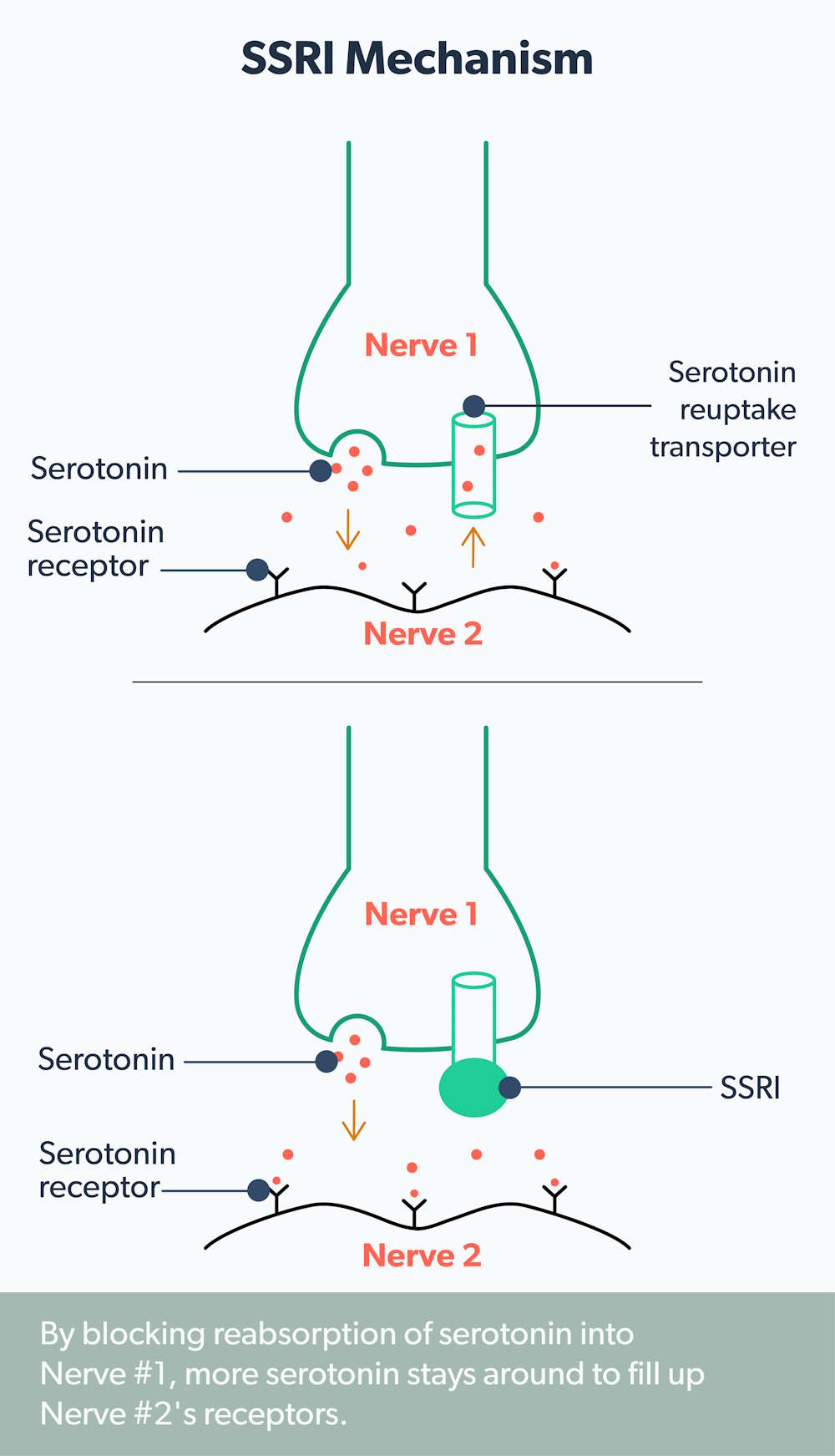Understanding Cipralex (Escitalopram) – Full Guide
Table of Contents
Escitalopram, known by its brand name Cipralex, is a medication prescribed primarily for the management of anxiety disorders and depression.
Understanding what is Cipralex, proper usage of Cipralex for anxiety, Cipralex (escitalopram) dosage, and potential Cipralex side effects is crucial for optimizing therapeutic outcomes.
What is Cipralex?
Cipralex, or Escitalopram, is a medicine classified as a selective serotonin reuptake inhibitor (SSRI). It is a widely prescribe medication for the treatment for depression and anxiety disorders. As an SSRI, it functions by selectively inhibiting the reuptake of serotonin, a neurotransmitter in the brain, thereby increasing its availability in the synaptic clefts between neurons.
By precisely targeting serotonin reuptake, Cipralex helps regulate mood, emotions, and anxiety levels in individuals experiencing mental health conditions. Its efficacy in this regard has made it a widely prescribed medication for various psychiatric disorders.
-

Cipralex® Escitalopram Tablets
Escitalopram Oxalate 5mg / 10mg / 20mg
Size: 60 Tablets
Brand name: Lexapro, Lexam, Mozarin, Aciprex, Depralin
From USD $28.00 Select options -

Brintellix® Vortioxetine Tablets
Vortioxetine 5mg / 10mg / 20mg
Size: 30 Tablets
Brand name: Trintellix, Fonksera
From USD $42.00 Select options -

Serta® Sertraline Tablets
Sertraline 50mg / 100mg
Size: 45 Tablets
Brand name: Zoloft
From USD $28.00 Select options
How Does Cipralex Work?
Cipralex, also known as Escitalopram, operates through a specific mechanism of action that influences neurotransmitter activity within the brain.
Mechanism of Action:
Cipralex primarily acts as a selective serotonin reuptake inhibitor (SSRI). Serotonin is a neurotransmitter responsible for regulating mood, emotions, and anxiety levels. In individuals with anxiety disorders, there may be an imbalance or insufficient levels of serotonin in the brain. Cipralex works by blocking the reuptake of serotonin, meaning it prevents the serotonin that is released from being absorbed back into the neurons. This results in increased levels of serotonin in the synaptic space between neurons, which enhances neurotransmission and communication within the brain circuits involved in mood regulation.
By increasing serotonin levels in the brain, Cipralex helps regulate mood and alleviate symptoms associated with anxiety disorders. Anxiety disorders are often characterized by persistent and excessive worry, fear, and physical symptoms such as restlessness, tension, and palpitations. The enhanced serotonin activity facilitated by Cipralex helps modulate these symptoms by promoting feelings of calmness, reducing excessive worry, and alleviating physical manifestations of anxiety.
Uses of Cipralex
Cipralex (Escitalopram) is prescribed for various mental health conditions, with its primary indication being the treatment of generalized anxiety disorder (GAD). Here’s an overview of its uses:
Primary Indication: Treatment of Generalized Anxiety Disorder (GAD) and Related Conditions:
- Cipralex for anxiety is FDA-approved and widely used for the treatment of generalized anxiety disorder (GAD), a common mental health condition characterized by persistent and excessive worry or anxiety about various aspects of life.
- Cipralex for anxiety helps alleviate symptoms such as excessive worrying, restlessness, irritability, muscle tension, and difficulty concentrating, thereby improving overall functioning and quality of life.
- Cipralex is effective in managing GAD symptoms in adults and adolescents, providing relief from the debilitating effects of this condition.
Potential Off-label Uses:
- Depression: Cipralex is frequently prescribed off-label for the treatment of depression, another prevalent mood disorder characterized by persistent feelings of sadness, hopelessness, and loss of interest or pleasure in activities.
- Panic Disorder: Cipralex may be used off-label for the management of panic disorder, a type of anxiety disorder characterized by recurrent panic attacks accompanied by intense fear or discomfort.
- Obsessive-Compulsive Disorder (OCD): Some healthcare providers prescribe Cipralex off-label for the treatment of obsessive-compulsive disorder (OCD), a chronic condition characterized by intrusive thoughts (obsessions) and repetitive behaviors or rituals (compulsions).
- Social Anxiety Disorder (SAD): Cipralex may also be utilized off-label for the treatment of social anxiety disorder (SAD), a condition marked by overwhelming fear of social situations and performance anxiety.
- Other Conditions: Additionally, Cipralex may be considered for other mental health conditions where selective serotonin reuptake inhibitors (SSRIs) have demonstrated efficacy, under the guidance and discretion of a healthcare provider.
Escitalopram Dosage
Proper Escitalopram dosage is essential for achieving optimal therapeutic outcomes while minimizing the risk of adverse effects. Here’s a breakdown of the dosage considerations:
Recommended Starting Escitalopram Dosage for Adults:
- The typical starting dosage of Escitalopram for adults is 10 mg once daily, administered orally.
- This initial dosage may be adjusted based on individual response and severity of symptoms, as determined by the prescribing healthcare provider.
- In some cases, healthcare providers may initiate treatment at a lower dosage, especially in individuals who are more sensitive to medications or have specific medical conditions.
Adjustment of Escitalopram Dosage Based on Individual Response:
- Following the initiation of treatment, the dosage of Escitalopram may be adjusted gradually over time.
- Healthcare providers may increase the dosage in increments of 5 mg at intervals of at least one week, depending on the patient’s response and tolerability.
- It is crucial for patients to communicate openly with their healthcare providers regarding any changes in symptoms or side effects experienced during treatment, as this may prompt adjustments to the dosage regimen.
Special Considerations for Elderly Patients and Those with Liver or Kidney Impairment:
- Elderly patients or individuals with liver or kidney impairment may require lower starting dosages of Escitalopram compared to the general adult population.
- Healthcare providers may exercise caution and closely monitor these patients for potential adverse effects, as their bodies may metabolize the medication differently.
- Dosage adjustments should be made cautiously and under the supervision of a healthcare professional, taking into account the medical history, current health status, and potential drug interactions.
How to Use Cipralex
Proper administration of Cipralex (Escitalopram) is crucial for its effectiveness and safety. Here’s a detailed guide on how to use Cipralex:
Guidance on Administration:
- Cipralex is typically administered orally in the form of tablets or oral solution.
- It can be taken with or without food, depending on individual preference and tolerability.
- It is essential to swallow the tablet whole with a glass of water, without crushing, chewing, or breaking it, unless otherwise instructed by the healthcare provider.
- If using the oral solution, it should be measured with the provided dropper and mixed with water, orange juice, or apple juice, and then consumed immediately.
- The dosage and frequency of administration should be strictly adhered to as prescribed by the healthcare provider.
Caution Regarding Abrupt Discontinuation:
- Abrupt discontinuation of Cipralex should be avoided, as it may lead to withdrawal symptoms or a relapse of the underlying condition.
- If discontinuation of Cipralex is necessary, it should be done gradually under the guidance of a healthcare professional, who may gradually reduce the dosage over time.
- Patients should never discontinue or adjust the dosage of Cipralex without consulting their healthcare provider, as abrupt changes may result in adverse effects and compromise treatment outcomes.

What are the Side Effects of Escitalopram?
Escitalopram, like any medication, can cause side effects, which can range from mild to severe. It’s crucial for patients to be aware of these potential side effects and to seek medical attention if necessary. Here’s what you need to know:
Common Cipralex Side Effects:
- Nausea: Feeling of discomfort or queasiness in the stomach, often accompanied by an urge to vomit.
- Headache: A dull or throbbing pain in the head, which may vary in intensity and duration.
- Drowsiness: Feeling excessively sleepy or fatigued, which may impair cognitive and motor functions.
- Dry Mouth: Sensation of dryness or discomfort in the mouth due to decreased saliva production.
- Insomnia: Difficulty falling asleep or staying asleep, leading to inadequate rest and daytime fatigue.
Serious Cipralex Side Effects:
- Suicidal Thoughts: In some cases, antidepressant medications like escitalopram may increase the risk of suicidal thoughts or behaviors, particularly in young adults and adolescents.
- Serotonin Syndrome: A potentially life-threatening condition characterized by excessive serotonin activity in the brain, which can cause symptoms such as confusion, agitation, rapid heartbeat, high blood pressure, fever, sweating, tremors, and in severe cases, seizures.
- Allergic Reactions: Rarely, escitalopram may trigger allergic reactions, which can manifest as skin rash, itching, swelling of the face, tongue, or throat, difficulty breathing, and severe dizziness.
Importance of Monitoring for Adverse Effects and Seeking Medical Attention:
- Patients should closely monitor themselves for any unusual symptoms or Cipralex side effects while taking escitalopram.
- It is essential to report any new or worsening symptoms to a healthcare provider promptly.
- If experiencing severe or concerning side effects, such as suicidal thoughts, serotonin syndrome symptoms, or allergic reactions, immediate medical attention should be sought.
- Healthcare providers may adjust the dosage or recommend alternative treatments if side effects become intolerable or severe.
Frequently Asked Questions (FAQs) About Cipralex
What is Cipralex Medication?
Cipralex medication is a brand name for the generic drug escitalopram, which is used to treat anxiety disorders and depression. It is available in tablet or oral solution form and is typically taken once daily. Cipralex belongs to the class of drugs known as selective serotonin reuptake inhibitors (SSRIs), which work by increasing serotonin levels in the brain to improve mood and reduce anxiety symptoms.
What is the Difference Between Cipralex and Escitalopram?
Cipralex and escitalopram are the same medication, with Cipralex being the brand name and escitalopram being the generic name. Both contain the active ingredient escitalopram oxalate and have the same pharmacological properties and therapeutic effects. The primary difference between the two is the name and the manufacturer. Generic escitalopram may be less expensive than the brand-name Cipralex, but both are equally effective in treating anxiety disorders and depression when taken as directed under the guidance of a healthcare professional.
Cipralex: How Fast Does it Work?
The onset of action of Cipralex can vary from person to person. While some individuals may experience symptom relief within a few weeks of starting treatment, others may require several weeks of consistent use before noticing significant improvements. It’s essential to continue taking Cipralex as prescribed by a healthcare provider, even if benefits are not immediately apparent, as it may take time for the medication to reach its full therapeutic effect.
How to Withdraw from Cipralex
When discontinuing Cipralex, it’s crucial to do so gradually under the guidance of a healthcare professional to minimize the risk of withdrawal symptoms and recurrence of symptoms. The dosage should be tapered slowly over several weeks or months, depending on the individual’s response to the medication and the duration of treatment. Abrupt discontinuation of Cipralex may lead to withdrawal symptoms such as dizziness, nausea, headache, irritability, and flu-like symptoms. Healthcare providers can provide personalized guidance on tapering schedules and monitor for any adverse effects during the withdrawal process.
References:
- https://www.tandfonline.com/doi/abs/10.1517/13543784.11.10.1477
- https://journals.lww.com/intclinpsychopharm/abstract/1994/03001/pharmacological_characterization_of_selective.4.aspx
- https://www.tandfonline.com/doi/abs/10.1080/13651500410005504
- https://onlinelibrary.wiley.com/doi/abs/10.1002/da.10146
- https://link.springer.com/article/10.2165/00003495-200565160-00013
- https://www.psychiatrist.com/wp-content/uploads/2021/02/13329_escitalopram-treatment-panic-disorder-randomized-double.pdf
- https://www.tandfonline.com/doi/abs/10.1185/030079907X178838
- https://www.sciencedirect.com/science/article/pii/S0924977X16000675
- https://academic.oup.com/ijnp/article/7/3/283/681889
- https://www.ncbi.nlm.nih.gov/pmc/articles/PMC2719451/
Post by:
Dr.Marcella Jiovanni
Health and Beauty Expert
“Marcella Jiovanni actively promotes the importance of maintaining healthy skin, she envisions the future of dermatology as moving away from pure medical, pharmacological dermatology and flowing more toward a holistic approach to wellness and skincare.”

















